Characteristic features of various types
Each of the types of roses has its own, only inherent features.
Hybrid tea
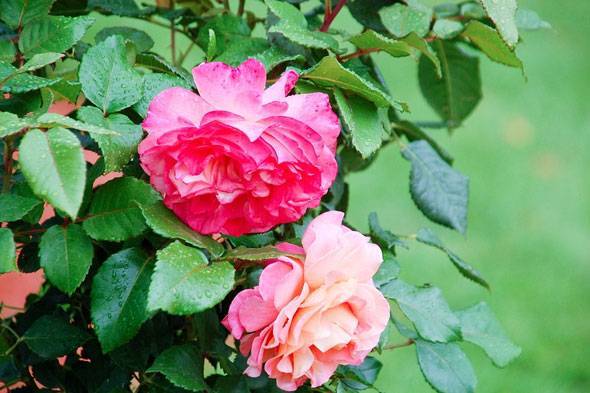
The most numerous species. They grow in height from 60 cm to 1 meter. The bushes are slightly spreading, the branches are straight. They have a very high quality of flowers. The main characteristic is the pointed shape of the inflorescences. Flowers are double and double. They look very impressive in the form of a standard plant.
English (David Austin)
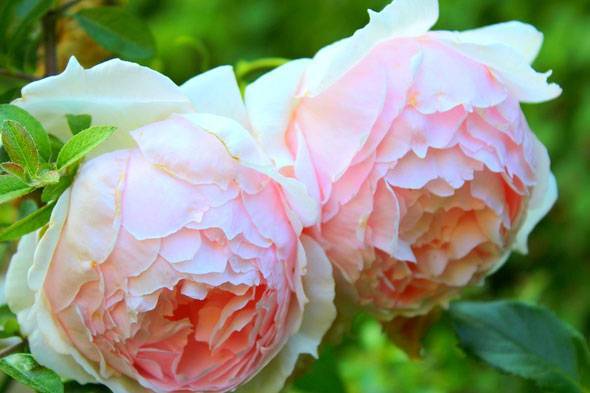
Roses of a famous English breeder. Tall, have a very large, wide flower. A distinctive feature is the strongest aroma. The number of varieties in this group is already more than 200. However, officially, they have not yet been singled out as a separate species. They have an incredible demand in the flower market.
Climbing
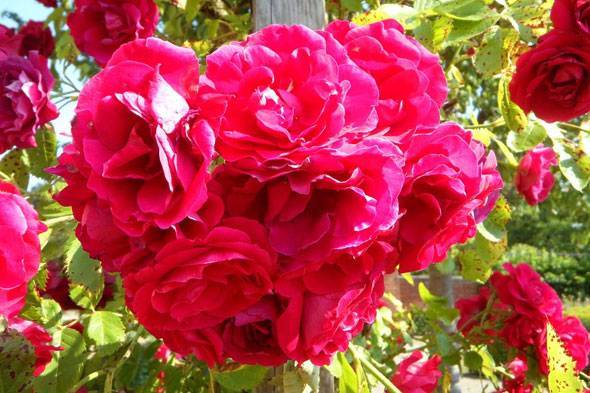
This is the name for roses with long shoots that braid the support. They are used to decorate arches, awnings, pergolas. There are two types - creeping and climbing. The former bloom once a year and need annual pruning. The latter have several waves of flowering per season. No cropping is needed.
Polyanthus (multi-flowered)

Dense, small bushes up to 40 cm tall. Small flowers are collected in large inflorescences - up to 100 roses in one. They have almost no smell, but they bloom continuously from late spring to late autumn. They tolerate frost well. Forcing is possible in greenhouse and indoor conditions.
Park
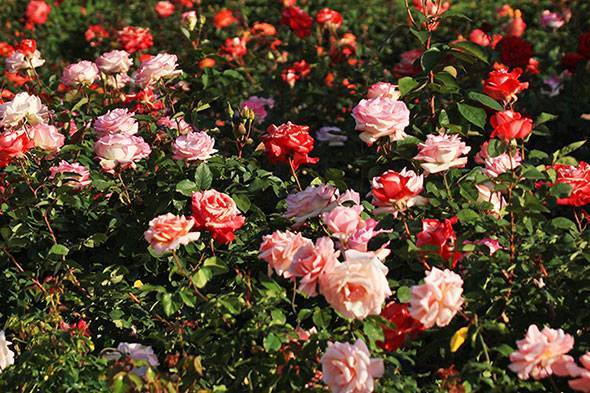
These include ancient varieties that can survive the harsh winter outdoors. The bush is one and a half meters high. Bloom in early summer for about a month. The flowers are like wild rose. Their color ranges from white to purple. Sometimes it is orange. Used in group plantings and in hedges. The wrinkled rose also belongs to this species.
Groundcover

This is a new group. Roses of this type are easily recognizable: branches grow mainly to the sides, sometimes up to 4 m. Height is not more than 50 cm. Flowering is long. They have shiny leaves. They grow in a solid carpet. Some varieties of this type bloom 1 time, others 2 times. Serve as an excellent decoration for any site. They do not get sick and are not afraid of frost.
Stamp
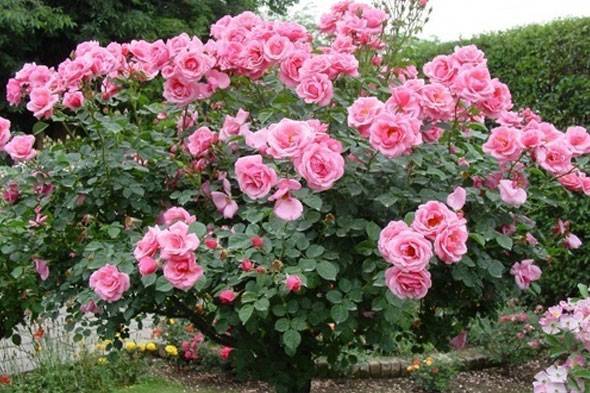
They are not a separate species. These are roses grown using special techniques. A cultivated rose is grafted onto a single, long shoot of a rose hip. It can be of any kind and type. It turns out a rose tree in the form of a huge bouquet. It is considered the best garden decoration.
Miniature
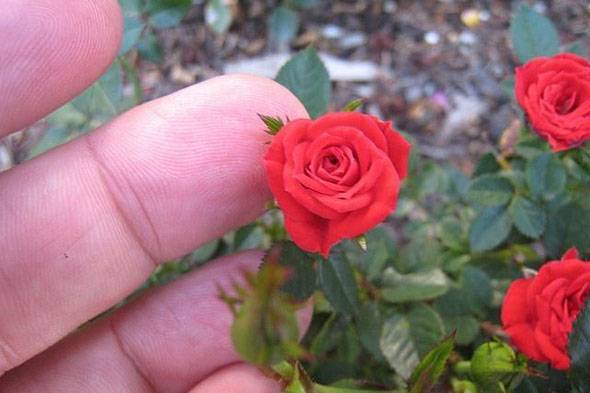
This species was recently bred by breeders. The height of the bush is from 15 to 25 cm. The stems are densely covered with small, shiny leaves. Can be studded or studless. The flowers are very small, of different colors. Blossom singly or in inflorescences until the first frost. Grown on curbs or in containers. Growing in an apartment is allowed. The species tolerates frosts well, does not get sick. It is weakly affected by pests.
Curb
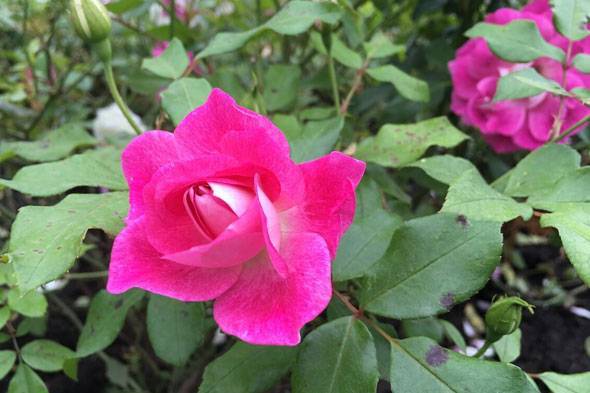
Low-growing shrubs up to 70 cm high. They quickly take root in a new place. They bloom for a long time. They differ from ordinary roses in double flowers with fancy edges and an unusual shape. Can be grown in apartments.
Shrub (also called shrubs)
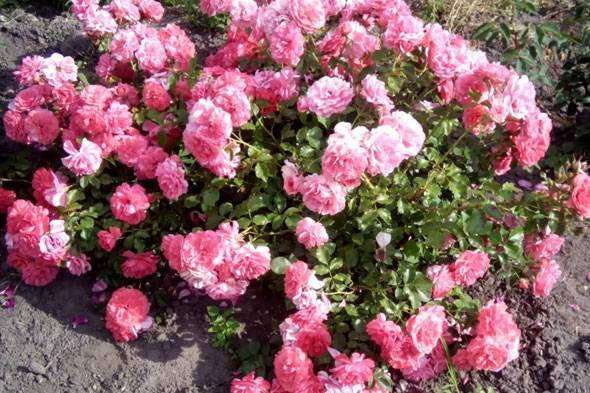
Large bushes up to 2 meters high. They can be both upright and semi-vine. Less capricious than tea varieties. Pruning is not difficult, even for beginners. They require shelter for the winter. Long-lasting and abundant flowering. They are used in both vertical and horizontal landscaping.
The above method for determining the type of roses, of course, will require some work, but if you deeply delve into its essence, you can well become the owner of the key to unraveling any grown flower.
Features of a climbing rose, characteristic only of this group
 There are many cases when, in favorable conditions, branches of climbing roses grow over 10 m in length.
There are many cases when, in favorable conditions, branches of climbing roses grow over 10 m in length.
During the period of growth and flowering, it is not difficult to distinguish climbing roses from other relatives.
- Mature bushes grow long shoots.
- The crown is flexible, in any case, the growth of the current year. That allows you to bend the whips for shelter for the winter.
- Most varieties have a spreading crown and need support.
- The color of the leaves is often dark, the plates are dense. Although, it depends on the parental varieties involved in hybridization. There are climbing roses with small and light leaves.
Growing and caring for the White Bear rose
Rose Polar Bear loves sunlight, but the rays should not be direct, since the white color strongly attracts ultraviolet light. Scattered rays are desirable above the plant. The variety should not be planted in low-lying areas where moisture stagnates.
Diseases
Does the rose have a gray-white coating or brown balls on the sheets? Methods of dealing with the disease.
Powdery mildew
Black spots appeared on the leaves of the rose, round in shape, what to do, how to save the plant?
Black spot
The rose is sprinkled with yellow powder, the leaves and stems crack and die, how to get rid of the disease?
Rust
Is there a gray bloom on the rose? This is a gray rot that needs to be removed as soon as possible.
Gray rot
For healthy growth and successful flowering, the "Polar Bear" needs fertile soil with a low pH level. In soil that is scarce in nutrients, the variety will grow more slowly, its flowering will be much worse.
For a seedling, you need to dig a hole 60-65 cm deep. This depth is necessary for a reserve so that a drainage layer of gravel or crushed stone fits on the bottom.
On top of the drainage, you need to put a layer of high-quality soil mixture, which includes peat, turf soil, manure and sand. This composition will increase the de-training of the soil and improve its chemical composition, which is necessary for fertility.
The soil under the plant must be regularly moistened. Watering is carried out at the root in the morning or evening with warm water (rainwater is recommended). The soil under the bush must not be allowed to dry out, so it is advisable to water it once a week in the summer and once every two weeks in the spring.
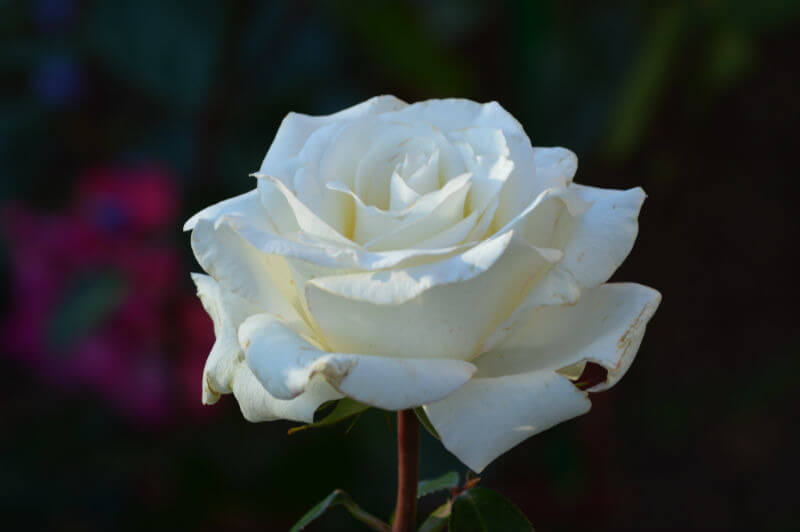
Top dressing is carried out every season. In the spring, nitrogen fertilizers are applied, in the summer during the budding period - mineral fertilizers, in the fall - fertilizing based on phosphorus and potassium. In order to reduce the amount of weed near the crop, timely loosening is necessary.
As a large amount of litter appears, weeding should be carried out in order to protect the plant from infection with parasites and fungi. In the fall or spring, it is required to carry out sanitary pruning of dead and affected branches.
In summer, it is recommended to remove dried buds immediately after flowering. The variety is winter-hardy, but in a harsh winter it is better to cover the plant with a covering greenhouse material. In light frosts, it is enough to cover the bush with peat or fallen leaves.
Pests
Microscopic spiders have appeared on the plant, and the rose is gradually covered with cobwebs, what should I do?
Spider mite
Are small green insects destroying your rose? Effective methods of pest control.
Green rose aphid
Caterpillars have appeared on the rose, which twist the leaves of the plant, how to deal with the pest
Rose leaf roll
Flat cones appeared on the shoots of a rose or on the underside of the foliage, how to deal with the pest
Rosaceous scale insect
Rose use options
White Bear is a tall shrub with neat shoots that do not grow on the sides. The variety is suitable for single plantings in flower beds or rose gardens. They can decorate the area in front of the house or gazebo.
Suitable for use in parks.As compositions, the rose will look good with bright contrasting annuals of lilac, blue, burgundy, rich yellow and orange colors.
Looks good in the center of a mixborder or in the background with low-growing crops in front. Suitable for cutting, buds stand in water for a long time.
Useful Tips
- During the period of abundant flowering, the shrub may lose shape, its shoots may bend to the ground due to the severity of the buds. To avoid branch breakage, it is necessary to create a support for the plant;
- Mulching will reduce the amount of watering. By adding mulch, moisture under the bush stays longer. Peat and humus are suitable as mulch;
- A cut rose will stay in water much longer if you add a special freshness powder, sold at a flower shop, to the vase.
Pros and cons of White Bear
Advantages:
- Large snow-white flowers that remain fresh for a long time;
- Intense, pleasant aroma;
- Compact, tall shrub;
- Frost resistant;
- Suitable for the Russian climate;
- Practically does not get sick;
- Suitable for cutting.
Disadvantages:
- Afraid of high humidity;
- Requires careful selection of a landing site.

Flowers hybrid tea roses in the garden (with photo)
Here is a general description and photo of hybrid tea roses with the main characteristics of this class of plants:
The general description of bushes of hybrid tea roses corresponds to the following parameters: erect or slightly spreading, strong shoots, straight or slightly articulated.
These flower beds have low bushes (60-80 cm), large leaves, consisting of 5-7 leaves, beautiful, of various shades.
Flowers of various beautiful colors, with an excellent aroma, large (on average 10 - 12 cm in diameter), double, single or more often collected in small inflorescences. Flowering lasts 30-35 days, then there is a break from 15 (in early varieties) to 30 days (in late varieties), after which flowering resumes and is no longer interrupted until late autumn.
All varieties of hybrid tea roses are very decorative in bush and standard form, in flower decoration of garden plots, and are also used for cutting. Suitable for winter forcing under glass.
Look at the photo of hybrid tea roses in the garden - with proper care, these plants can live for several decades:
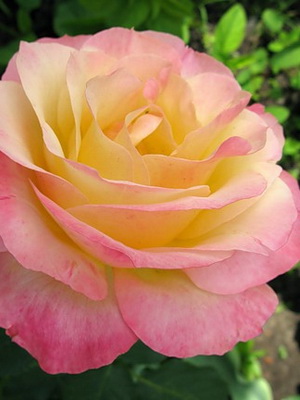
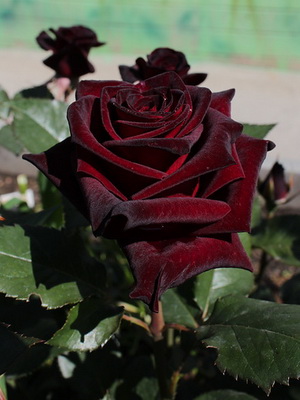
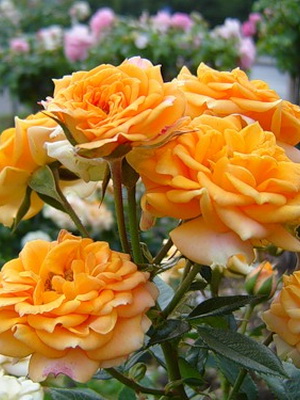
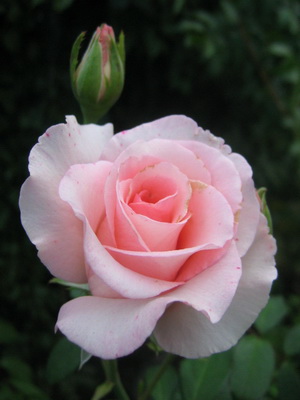
All gardeners know the names of such varieties of hybrid tea roses as: "Gloria Day", as well as "Baccarat", "Clementine", "Interflora", "Flamingo".
What other varieties of hybrid tea roses are, their photos and descriptions can be found on this page.


